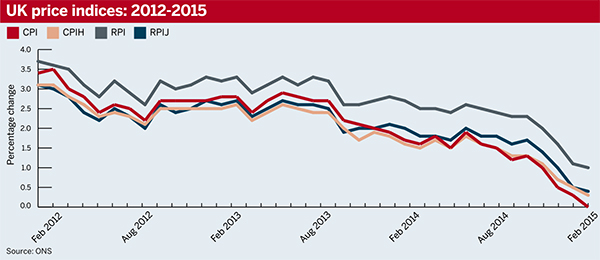Analysis: Whether a short-term blip or a longer-term trend, the latest fall in the consumer price index will make schemes sit up and ask themselves whether they could withstand the impact of a move into deflation.
Figures from the Bank of England last week showed UK inflation falling to zero in the year to February.
Industry experts are divided on how the latest figures might impact pension schemes because of divergent opinions about how long this deflationary period will last.

Falling inflation
However, Raj Mody, UK head of defined benefit at consultancy PwC, says ultimately schemes should not overreact to the recent figures.
“It’s interesting to track the monthly measure, but I don’t think… we’ve got persistent deflation to stay, we’re talking about a short-term dip,” he says.
In Mody’s view, schemes’ pressing concern should be to have an effective contingency plan in place that guards against the impact of deflation over the longer term.
His message for schemes is: “Are you ready to do anything about it? Is [your] governance fit for purpose if it did merit quick reaction?”
Dropping from January’s 0.3 per cent and December’s 0.5 per cent, CPI came in below analysts’ forecast of 0.1 per cent and is the lowest level recorded since the Office for National Statistics began generating such data in 1996, with some suspecting these levels were last reached more than 50 years ago.
According to the ONS, price movements for a range of recreational goods, food and furnishings were major contributors to the latest CPI slowdown, despite increases over the same period in clothing and rent.
Low levels of inflation reduce the likelihood of interest rate hikes in the near future, which could provide a much-needed respite for schemes battling increasing deficits.
In a speech earlier this month Bank of England chief economist Andy Haldane suggested the risk of falling inflation expectations put the chances of rate hikes on a par with rate cuts, saying the two were “broadly evenly balanced”.
Are you ready to do anything about it? Is [your] governance fit for purpose if it did merit quick reaction?
Raj Mody, PwC
The CPI’s downward trend has fed a lower-for-longer mood over recent months, and for trustees of DB schemes the outlook is pretty bleak.
Ten-year gilt yields had fallen to around 1.6 per cent by the middle of March, following weak wage growth data. And 30-year gilts are currently yielding around 2.3 per cent.
Short-term blip
While the latest CPI figures continue a downward trend, industry experts stress the consensus view that inflation will start to climb back up late this year.
In its quarterly inflation report of February 12, the BoE’s Monetary Policy Committee said: “The outlook for domestic costs remains consistent, with inflation returning to the 2 per cent target as the drag from lower energy, food and import prices dissipates.”
Watch the wedge
The current inflation environment creates some opportunity for pension schemes using liability-driven investment strategies.
Shajahan Alam, LDI solutions strategist at Axa Investment Managers, says schemes should take advantage of the current gap between CPI and the retail price index. RPI for February came in above a 0.8 consensus expectation at 1 per cent.
Pension schemes with LDI strategies may have CPI liabilities but will hedge using RPI-linked gilts and derivatives.
“What’s interesting for pension schemes is termed the 'wedge', the difference between the two,” says Alam. “If that wedge is higher than expected, you’ve got [a situation] where you’re getting paid in RPI.”
“To the extent that RPI is higher than CPI you can make a bit of a profit,” he adds.
Richard Gibson, associate at consultancy Barnett Waddingham, views the latest figure as a temporary blip, a distortion led by the fall in oil prices.
In general, he says, inflation is a liability for pension schemes rather than an asset. “They have to revalue their benefits in deferment and they have to pay their pensions in payment indexed with the CPI market indices,” Gibson explains, adding: “Generally, inflation expectations falling long-term is good news for pension schemes.”
He also says the fall is unlikely to affect the long-term prices for inflation protection.
However, Gibson says, the key date in the CPI calendar for pension schemes will be September, the month used by many schemes to measure pension increases and revalue deferred members for the following year.
An exception to this rule, though, is the Pension Protection Fund, which bases pension increases on the CPI figure in May.
“If the CPI hasn’t recovered by May then this could be quite bad news for PPF pensions,” says Gibson.
“If it persists to September it could be more significant from a pension scheme point of view.”
Inflation-linked pensions have a floor of 0 per cent to protect the real value of benefits being eroded in times of deflation.
David Robbins, senior consultant at Towers Watson, says CPI will need to increase by 0.8 per cent over the next seven months to avoid this zero floor impacting schemes’ funding positions.
“If prices rise by less than 0.8 per cent, CPI annually [could] be negative – then the 0 per cent floor would start to bite,” says Robbins.
Long-term risks
Should CPI figures move against consensus expectations over the coming months the outlook could be considerably worse for pension schemes, hitting both asset values and liabilities.
Matthew Giles, head of the Birmingham pensions team at law firm Squire Patton Boggs, says: “Deflation impacts on each of the three key components of defined benefit pension arrangements: assets, liabilities, and the ability of the employer to make good the difference between the two.”
For example, an employer’s ability to address rising deficits might be hit by deflation if business cash flows are compromised by postponed consumer spending.
“For those employers hanging on [to DB arrangements] by their fingertips it could be another nail in the coffin, and we’re running out of room for nails,” says Giles.














